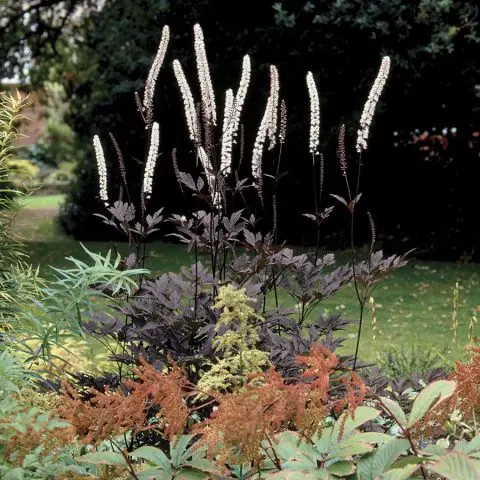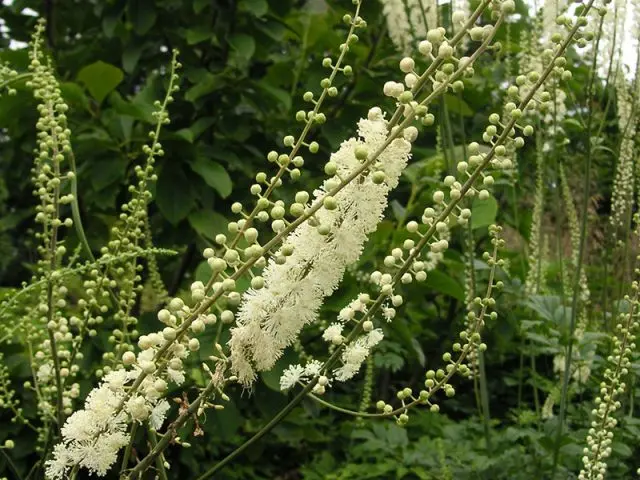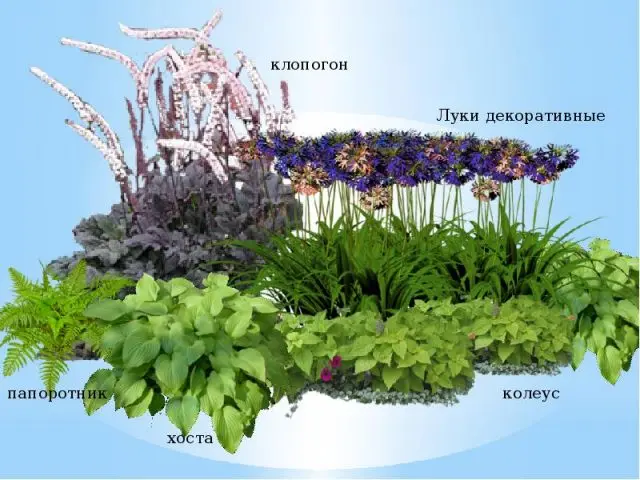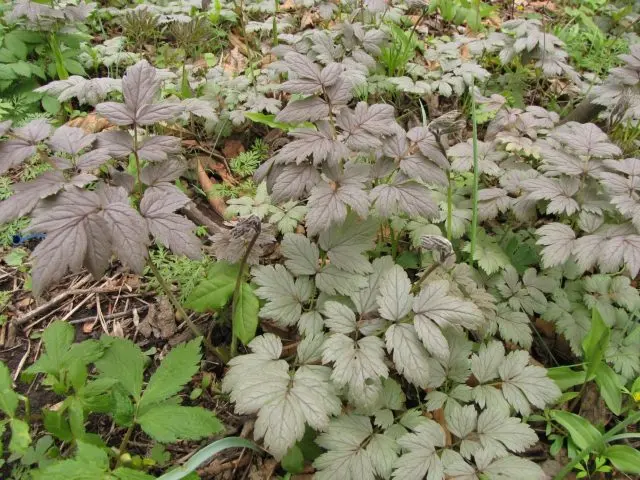Contents
Planting and caring for black cohosh is within the power of the most inexperienced gardeners, and the result is able to decorate the garden for several decades. The plant is considered the most elegant representative of perennial crops from the ranunculus family. Elegant, tall candle flowers are popular in the design of gardens, parks, flower beds around the world, are used in the preparation of bouquets and in folk medicine.

What is this plant “klopogon”
Black cohosh or in Latin – “cimicifuga” in different cultures received different names. The green parts of the plant and the roots contain insecticidal substances that can repel insects, which is reflected in the Latin and names of the culture. The most accurate description of the appearance and unusual beauty of flowers is their German name – “silver candles”.
A large plant with tall, powerful flower stalks can reach a height of 2 m. Depending on the variety and illumination, average black cohosh specimens grow from 40 to 100 cm.
With age, black cohosh develops a powerful root that goes deep into the soil. This provides a long-lived perennial with resistance to heat, frost, and drought.
Large, bright leaves rise from the ground, collected in a tall sprawling rosette. Depending on the species, leaf plates can be painted in all shades of green, have a reddish, blue tint, or be completely chocolate-burgundy. The shape of the leaves is thrice dissected, serrated, vaguely reminiscent of a very large parsley.
From the rosette of basal leaves rises one, less often – two strong shoots. At the end, a large peduncle of a cylindrical or elongated-pointed shape is formed. The black cohosh inflorescence combines hundreds of small buds with small petals but very long stamens, giving the flowers a fluffy appearance.

The color of black cohosh flowers depends on the variety and varies widely from pale green to white and from bright pink to pale purple. The opening of the buds begins at the base of the “candle” and gradually rises to the tip. The flowering period can be extended up to 40 days, in early species it begins in July, in later species in September or October.
The use of black cohosh in landscape design
A variety of types of cimicifuga in height, length of inflorescences, their color allows you to create many compositions in flower beds, alpine slides, borders. Black cohosh in garden design can both create a bright accent and become a backdrop for other plants.
When planting alone, you should choose high, bright varieties: European or Daurian cimicifuga, atropurpurea. The same species are often used to decorate the shores of reservoirs, grown along fences or walls. Medium-sized black cohosh looks good on prefabricated flower beds, and rock gardens, borders, and flower beds adorn rock gardens with undersized cimicifuga.
Black cohosh in landscape design, as seen in the photo, can be perfectly complemented by low-growing or cover crops. Hosta, maple leaf, anemone, perennial moss, wild hoof not only decoratively frame plantings of cimicifuga, but also serve as protection for the ground. Curly lungwort, bruner perform well the mulching function.

Fern, aconite, sedge, buzulnik, astilba grow well next to black cohosh. Coniferous plants and bergenia serve as a noble background, shading the beauty of flowers and leaves.
How does black cohosh reproduce
Having a perennial bush in the garden, it is easy to propagate black cohosh, getting several plants in the shortest possible time. To do this, you can use one of three methods: germination from seeds, cuttings, division of an adult bush.
Blooming, fragrant black cohosh from seeds is the hardest to get. This will take about six months before germination and a few more years of cultivation before the flowers appear. Vegetative methods are fast, but unreliable. Planting material of black cohosh often dies due to temperature changes, bright sun or drying out of the soil, waterlogged seeds rot.
Cutting
The procedure for propagation by parts of the stem is best done in the spring. Black cohosh cuttings cut in autumn need to be rooted and grown before planting at home, which requires more attention. This method does not greatly disturb the mother bush; for reproduction, it is enough to separate a leaf from it with a small fragment of the central stem (the so-called “heel”).
From an adult cimicifuga bush, you can get several independent sprouts that form every season around the main root. For guaranteed rooting, the cutting is placed with its heel in a growth stimulator for several days, and then planted in loose, moist soil.
Division of the bush
An adult healthy bush of black cohosh grows in width every year and takes up more and more space in the flower bed. A 5-6-year-old plant can already be propagated by dividing the bush into parts. The plant is previously removed from the ground, dug deeply from all sides.
The bush is divided into several parts, depending on its age and size. Moreover, it is better not to damage the main rhizome, carefully cutting off only young shoots with shoots or live buds. Separated cimicifuga bushes are planted in other flower beds or grown in containers for better survival. The mother plant can be buried in the old place.
Growing black cohosh from seeds
Seed propagation is a more painstaking task, it is used only when necessary. A short shelf life and limited germination of the material complicate the task. Growing from seeds of a simple black cohosh has several features.
Step-by-step instructions and tips for seed propagation of cimicifuga:
- Planting material collected in the fall loses its germination capacity with each month of storage. Therefore, it is better to start planting immediately after flowering.
- Black cohosh is sown in containers with a loose substrate, and then left in a warm room (not lower than + 20 ° C) for 90 days. Plantings are rarely watered, keeping the soil semi-dry.
- It is not recommended to cover the containers with a film for the “greenhouse” effect. Seeds of black cohosh under such conditions are prone to damping off.
- For another 90 days, it will be necessary to keep the containers at a temperature of about + 16 ° C, until germination.
Grow sprouts like ordinary seedlings. Planting plants in open ground is possible at any stage of development. It is important to monitor the air temperature in order to protect seedlings from recurrent cold weather.
Young cimicifuga when grown from seed will look like the photo for several seasons. The bush develops and grows stronger, but flowers will appear on it only after 4-5 years.

Planting and caring for black cohosh
Much of the success of growing black cohosh starts when you plant it. The perennial develops well up to 25 years in a permanent place, while it is difficult to accept transplants. Therefore, the site should be evaluated very carefully. Proper planting and careful care of the Black cohosh plant may not work if the site is chosen incorrectly or seedlings are not carefully selected.
When purchasing seedlings in a nursery or growing them yourself, you should carefully examine each sprout before planting in a flower bed. There should be no spots on leaves, shoots, roots. When planting a seedling of black cohosh, the buds should be alive or have already begun vegetation, and the shoots should not be sluggish.
Optimal time for landing
Black cohosh can be planted in spring or autumn. Experienced gardeners recommend doing this after the cold weather ends and the air warms up to + 15 ° C. Spring planting provides black cohosh a whole season for rooting. Bushes go under the winter formed, so they are less prone to freezing or damping.
During the summer and autumn, the plant is gaining strength, adapting to the environment. With its condition, the black cohosh bush manages to show whether the site for cultivation is chosen correctly.
Choosing the right place
The uniqueness of cimicifuga is its ability to develop and bloom in partial shade. This property is very much appreciated by designers and amateur gardeners. Black cohosh makes it possible to decorate those places in the garden where other crops are reluctant to grow.
Soil preparation
Black cohosh, as a tall and profusely flowering plant, needs enhanced nutrition. Prepare the soil for planting seedlings should be carefully:
- The selected area is dug deep, adding sand, peat, and mineral supplements if necessary. It is not necessary to lime the soil – black cohosh loves acidic soils.
- Since the cimicifuga has been growing in one place for more than 20 years, planting pits are arranged no less than 50 * 50 cm with a distance of at least 0,6 m between the bushes.
- Drainage is necessarily laid at the bottom of the pit: expanded clay, small stones, broken brick, gravel.
- About 1/3 of the hole is filled with organic fertilizer mixed with garden soil. As a bookmark, rotted manure, compost are used, ash or complex fertilizers are added. On heavy soils, sand is mixed.
With proper dressing of planting pits, black cohosh will develop well and will require additional top dressing only after a few years of cultivation.
How to plant black cohosh
Plants are planted in prepared holes when the average daily temperature exceeds + 15 ° C, and the threat of night cooling has passed. It is advisable to transfer plants along with a clod of earth. If the root system of the seedling is open, the roots in the pit should be straightened so that they are directed inward.
It is not necessary to compact the soil tightly when planting black cohosh. The planting hole filled to the top is abundantly spilled with water. It is useful to mulch the surface around the bushes after planting with dry peat, grass or sawdust. This will conserve moisture and keep the soil loose.

Growing and caring for black cohosh
After planting, caring for the black cohosh flower consists in moderate watering, top dressing, and pruning. An important point is also the preparation of the plant for winter. You will not have to perform any more complex procedures when growing black cohosh.
Watering Schedule
Black cohosh loves moisture and does not tolerate drying out of the soil, which is clearly signaled by the wilting of leaves and peduncles. Overflowing the flower bed can also cause disease of the bush. Growing in places with stagnant moisture leads to the death of plantings.
According to gardeners, it is better to water the plants rarely, but plentifully, giving nourishment to deep roots. In the heat, cimicifuga bushes, even those in the shade, are watered every 3 days.
Does the plant need fertilizing?
Black cohosh is sensitive to soil fertility, but the correct laying of planting pits fully provides the plant with nutrition for the next 3 years.
Starting from the 4th season, black cohosh is fed for lush flowering and decorative foliage. Nitrogen fertilizers are applied in early spring. When laying buds, complex preparations for flowering crops or phosphorus-potassium mineral compounds are added to irrigation.
Loosening and mulching
Weeds rarely annoy adult plants, because the black cohosh has a lush rosette of leaves, creating a thick shadow under the bush. Therefore, weeding beds with cimicifuga will be required infrequently. It will simplify the care of decorative bushes by mulching or growing low plants nearby in a flower bed.
A layer of organic bulk materials up to 5 cm will protect the flower bed from drying out, keep the soil loose for a long time. Sawdust, foliage, peat are used as mulch.
Preparing black cohosh for winter
Adult black cohosh tolerates the winters of central Our Country well. Flower growers near Moscow claim that cimicifuga winters well without any shelter. In areas with severe winters or lack of stable snow cover, plantings can be covered with a layer of leaves or spruce branches.
Do I need to cut black cohosh for the winter
Before the onset of cold weather, the stems and leaves of the plant are cut off completely flush with the ground. This technique is usually enough to prepare black cohosh for wintering. After pruning, young bushes can be mulched with a layer of up to 10 cm. This technique is especially relevant in areas with severe winters or frequent temperature changes.
Pruning black cohosh at other times consists in thinning the foliage, removing faded shoots and decorative shaping the bush. Such formation can be carried out at any time of the warm season.
Diseases and pests
Proper planting and sufficient care of the black cohosh flower results in a healthy, strong bush, not prone to disease, not damaged by pests. The culture has a high immunity to fungal infections, including scab.
The plant gets sick most often due to waterlogging of the soil. In combination with cold soil, this condition can provoke infection with powdery mildew. Similar conditions develop in the spring with unexpected cold snaps at night. For prevention, black cohosh leaves appearing from the ground are sprayed with Bordeaux mixture, Fundazol or Topaz.
Mistakes when growing: why black cohosh does not bloom
Black cohosh foliage is bright, juicy, collected in luxurious bushes, decorative in itself. But, without waiting for flowering, beginner flower growers try to find and eliminate the cause. Often the plant does not throw out flower stalks or the buds that appear do not open, regardless of the quality of care.
Possible natural reasons why black cohosh does not bloom:
- Lack of sunny days. Although the plant is shade-loving, in a particularly cloudy summer, the flowers do not open, and the flower stalks wither.
- Cold spring or sudden cold snap in summer. Black cohosh flowers do not tolerate temperatures below + 15 ° C. Stems may not develop or buds may fall off.
- With prolonged drying of the soil or the formation of a dense crust on the ground, the plant begins to save nutrients and black cohosh may not bloom.
- Growing in too full sun or full shade can produce beautiful foliage but leave the plant without flower stalks.
Of the mistakes in care, the main obstacle to the development of cimicifuga is excess moisture, which provokes root rot. The lack of trace elements also adversely affects the condition of the bushes. The fact that it is time to feed the plant can be judged by the condition of the leaves, which become pale, dry out or wither.
Many black cohosh inflorescences appear in the middle of summer, but the flowers do not open immediately. Late-flowering species may simply not have time to fully develop in a temperate climate. If the summer in the region is short, and it gets cold early in autumn, the earliest varieties of cimicifuga should be chosen for cultivation.
Conclusion
Planting and caring for black cohosh is not difficult. To successfully grow an ornamental plant with amazing flowers that look like silver candles, you need to maintain a balance of light and shade, moisture and dryness of the soil. With minimal attention, black cohosh can decorate a garden for decades, becoming more beautiful every year.










